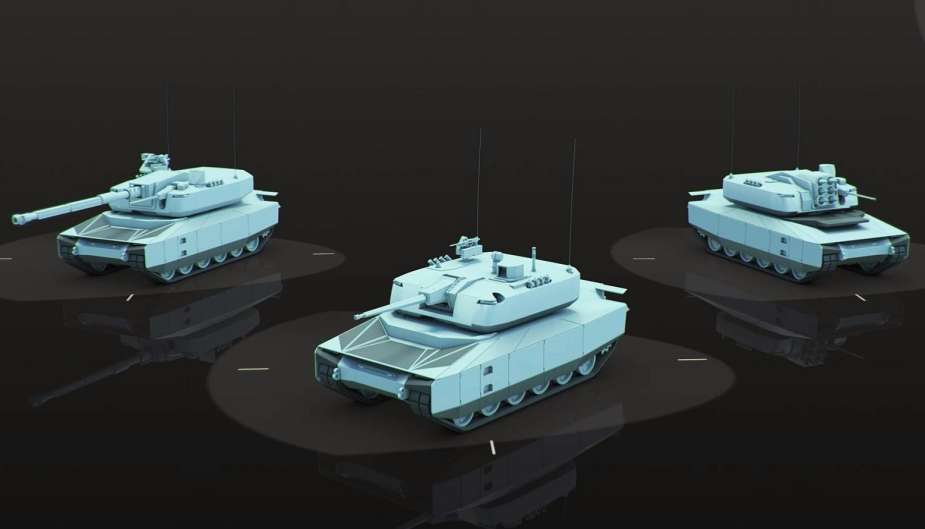Breaking news
What is MGCS Main Ground Combat System, nicknamed future Franco-German tank?.
The French Ministry of Defense reminds that, on September 22, Paris and Berlin breathed new life into the MGCS, the Main Ground Combat System. This extensive military project, born out of collaboration between France and Germany, aims to revolutionize the landscape of combat tanks and ground warfare by the horizon of 2040-2045.
Follow Army Recognition on Google News at this link

More than just a traditional heavy armored vehicle, the MGCS is conceived as a multi-platform system: a main battle tank equipped with a large-caliber cannon, accompanied by interconnected complementary modules (Picture source: French MoD)
Initiated in 2017 alongside the Future Air Combat System (SCAF), the MGCS is a Franco-German armament program. It aims to replace the German Leopard 2 tanks and the French Leclerc tanks while incorporating the latest technological advancements. More than just a traditional heavy armored vehicle, the MGCS is conceived as a multi-platform system: a main battle tank equipped with a large-caliber cannon, accompanied by interconnected complementary modules (a heavily armored vehicle equipped with powerful anti-tank missiles, a robotically assisted support vehicle armed with laser weapons, drones, and other innovative armaments).
The latest meeting between Sébastien Lecornu, the French Minister of the Armed Forces, and his German counterpart, Boris Pistorius, on September 22, marks a pivotal step in the development of the MGCS. Alongside the Chiefs of Staff of the armies of their respective countries, both men expressed their determination to advance the project by signing a common roadmap. The goal? To establish "common operational requirements" in stone.
This step will allow for the definition of the various technological pillars to be developed and clarify the responsibilities of each state. As the French Minister of the Armed Forces stated, the MGCS program is expected to be operational by the 2040-2045 timeframe.
Why is it called the "tank of the future"?
Artificial intelligence. The MGCS (Main Ground Combat System) will be equipped with significant technological breakthroughs, including AI. This AI will assist the crews by providing support for intelligence, planning, command, and coordination of fire. All of this analyzed data will enable rapid decision-making by the command. However, Martial, the capacity architect in charge of the MGCS at the Directorate General of Armaments (DGA), emphasizes that "humans will always be in the loop and, in fact, at the heart of decisions."
Hyper-connectivity. The operation of the MGCS will also rely on enhanced connectivity, allowing for real-time sharing of tactical information through an integrated combat cloud. In this way, different modules (or vehicles) will be able to instantly process, store, and distribute tactical data and coordinate their actions semi-automatically to combine their effects on the enemy.
"The MGCS is in line with the collaborative information-enhanced approach initiated by the Scorpion system," explains Delphine, responsible for the preparation of future ground combat systems at the DGA. Faced with new threats such as armed drones, autonomous weapons, and cyberattacks, the goal of the new multi-platform system is to create a combat environment in which fighters understand, decide, and act more quickly than the adversary to be more effective and better protected.
What are the main capabilities of the MGCS in combat?
Close combat: With the ability to fire at up to 8,000 meters, the striking power of the MGCS will be tenfold, which is twice the current standard of the Leclerc and Leopard tanks. The various modules accompanying the MGCS will greatly enhance their ability to engage the enemy through their number, mobility, and simultaneity. "They will also pose dilemmas and surprise effects for adversaries, which will complicate their decision-making," Delphine believes.
Observation: The MGCS ecosystem will enable observation up to 10,000 meters away, thereby improving target detection and anticipation capabilities.
Crew protection: Active camouflage, reinforced armor, countermeasures, and neutralization will be at the core of the MGCS's protective bubble, acting against both aerial and ground threats. Combined with the mobility provided by the distribution of weapons and equipment across multiple distinct platforms (thus containing their mass), this bubble will significantly contribute to the protection of the combatants.
All of these innovations will play a central role in the Titan project, which will succeed Scorpion starting in 2040. Its objective is to renew the decisive capabilities of the Army and further expand the ambition of collaborative air-land combat by articulating it with inter-service and allied levels.
Defense News October 2023


























